Solar eclipse of December 24, 1973
An annular solar eclipse occurred on December 24, 1973. A solar eclipse occurs when the Moon passes between Earth and the Sun, thereby totally or partly obscuring the image of the Sun for a viewer on Earth. An annular solar eclipse occurs when the Moon's apparent diameter is smaller than the Sun's, blocking most of the Sun's light and causing the Sun to look like an annulus (ring). An annular eclipse appears as a partial eclipse over a region of the Earth thousands of kilometres wide. Annularity was visible from southern Mexico, southwestern Nicaragua, Costa Rica including the capital city San José, Panama, Colombia including the capital city Bogotá, southern Venezuela, Brazil, southern Guyana, southern Dutch Guiana (today's Suriname), southern French Guiana, Portuguese Cape Verde (today's Cape Verde) including the capital city Praia, Mauritania including the capital city Nouakchott, Spanish Sahara (today's Western Sahara), Mali, and Algeria.
| Solar eclipse of December 24, 1973 | |
|---|---|
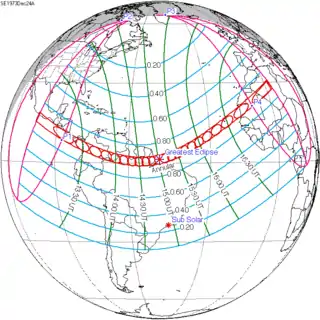 Map | |
| Type of eclipse | |
| Nature | Annular |
| Gamma | 0.4171 |
| Magnitude | 0.9174 |
| Maximum eclipse | |
| Duration | 722 sec (12 m 2 s) |
| Coordinates | 1.1°N 48.5°W |
| Max. width of band | 345 km (214 mi) |
| Times (UTC) | |
| Greatest eclipse | 15:02:44 |
| References | |
| Saros | 141 (21 of 70) |
| Catalog # (SE5000) | 9451 |
The duration of annularity at maximum eclipse (closest to but slightly shorter than the longest duration) was 12 minutes, 2.37 seconds in the Atlantic Ocean near the Brazilian coast. It was the longest annular solar eclipse until January 14, 3080, but the Solar eclipse of December 14, 1955 lasted longer.[1]
Related eclipses
Solar eclipses of 1971–1974
This eclipse is a member of a semester series. An eclipse in a semester series of solar eclipses repeats approximately every 177 days and 4 hours (a semester) at alternating nodes of the Moon's orbit.[2]
Note: Partial solar eclipses on February 25, 1971 and August 20, 1971 occur in the next lunar year set.
| Solar eclipse series sets from 1971–1974 | ||||||
|---|---|---|---|---|---|---|
| Descending node | Ascending node | |||||
| Saros | Map | Gamma | Saros | Map | Gamma | |
| 116 | 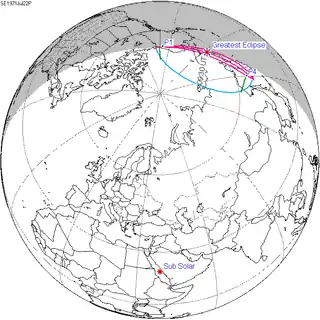 1971 July 22 Partial | 1.51298 | 121 | 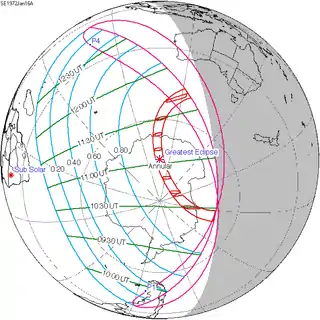 1972 January 16 Annular | -0.93651 | |
| 126 | 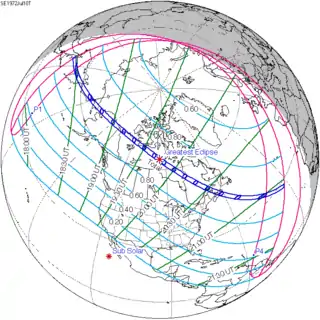 1972 July 10 Total | 0.68719 | 131 | 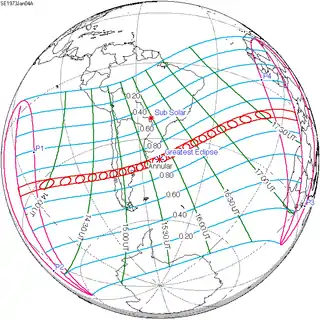 1973 January 4 Annular | -0.26441 | |
| 136 | 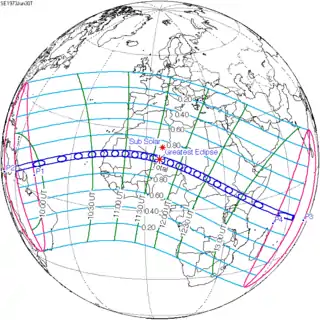 1973 June 30 Total | -0.07853 | 141 |  1973 December 24 Annular | 0.41710 | |
| 146 | 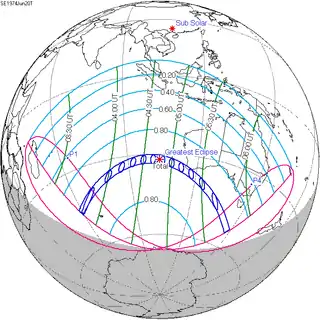 1974 June 20 Total | -0.82388 | 151 | 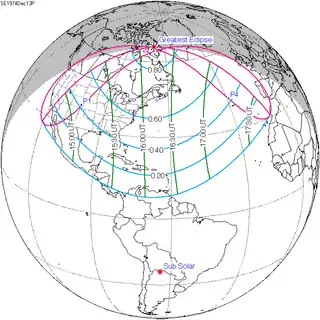 1974 December 13 Partial | 1.07974 | |
Saros 141
Solar saros 141, repeating every about 18 years, 11 days, and 8 hours, contains 70 events. The series started with partial solar eclipse on May 19, 1613. It contains 41 annular eclipses from August 4, 1739, to October 14, 2460. There are no total eclipses in this series. The series ends at member 70 as a partial eclipse on June 13, 2857. The longest annular eclipse occurred on December 14, 1955, with maximum duration of annularity at 12 minutes and 9 seconds. All eclipses in this series occur at the Moon’s ascending node.[3]
| Series members 17–36 occur between 1901 and 2259 | ||
|---|---|---|
| 17 | 18 | 19 |
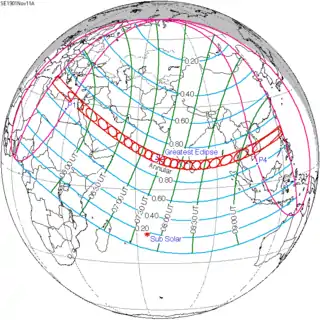 November 11, 1901 |
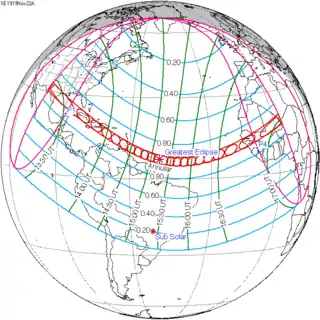 November 22, 1919 |
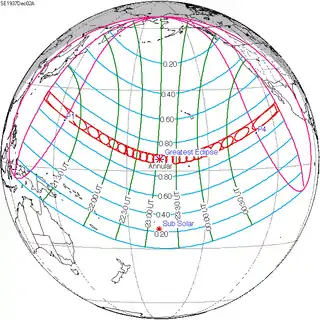 December 2, 1937 |
| 20 | 21 | 22 |
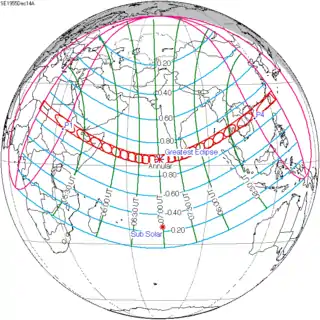 December 14, 1955 |
 December 24, 1973 |
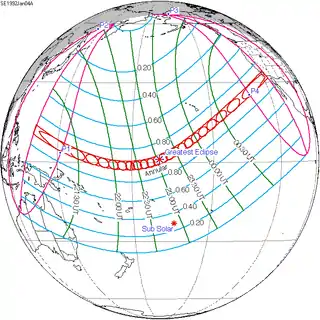 January 4, 1992 |
| 23 | 24 | 25 |
 January 15, 2010 |
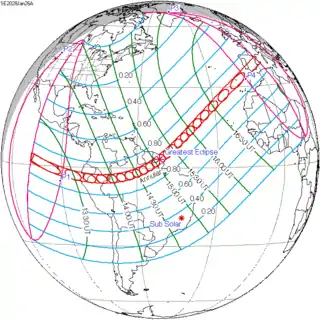 January 26, 2028 |
 February 5, 2046 |
| 26 | 27 | 28 |
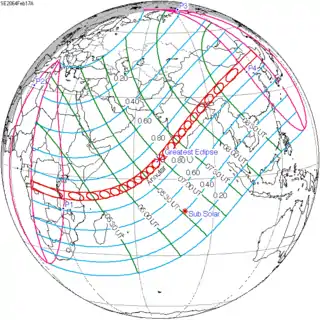 February 17, 2064 |
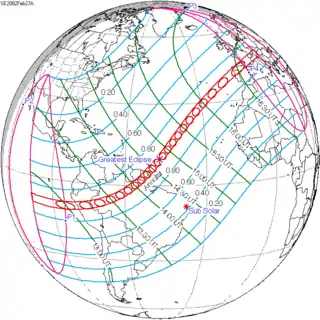 February 27, 2082 |
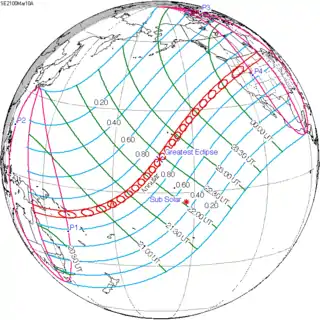 March 10, 2100 |
| 29 | 30 | 31 |
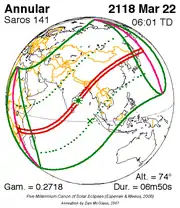 March 22, 2118 |
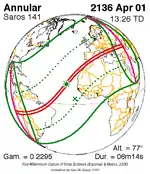 April 1, 2136 |
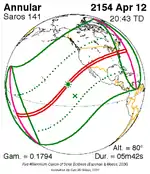 April 12, 2154 |
| 32 | 33 | 34 |
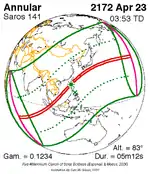 April 23, 2172 |
 May 4, 2190 |
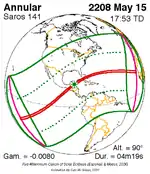 May 15, 2208 |
| 35 | 36 | |
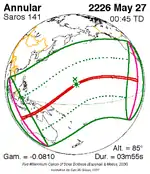 May 27, 2226 |
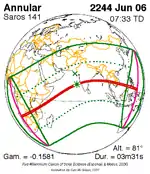 June 6, 2244 | |
Metonic series
The metonic series repeats eclipses every 19 years (6939.69 days), lasting about 5 cycles. Eclipses occur in nearly the same calendar date. In addition, the octon subseries repeats 1/5 of that or every 3.8 years (1387.94 days). All eclipses in this table occur at the Moon's ascending node.
| 22 eclipse events between December 24, 1916 and July 31, 2000 | ||||
|---|---|---|---|---|
| December 24–25 | October 12–13 | July 31-Aug 1 | May 18–20 | March 7–8 |
| 91 | 93 | 95 | 97 | 99 |
| December 23, 1878 | October 12, 1882 | July 31, 1886 | May 18, 1890 | March 7, 1894 |
| 101 | 103 | 105 | 107 | 109 |
| December 23, 1897 | October 12, 1901 | August 1, 1905 | May 19, 1909 | March 8, 1913 |
| 111 | 113 | 115 | 117 | 119 |
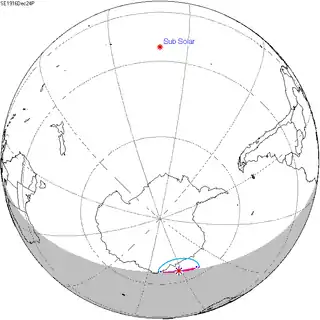 December 24, 1916 |
October 12, 1920 | 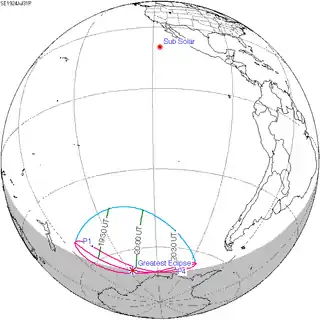 July 31, 1924 |
 May 19, 1928 |
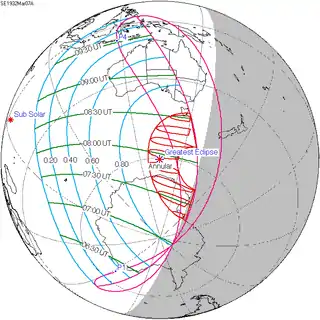 March 7, 1932 |
| 121 | 123 | 125 | 127 | 129 |
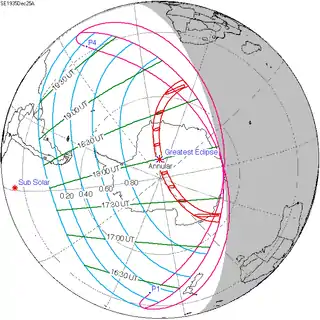 December 25, 1935 |
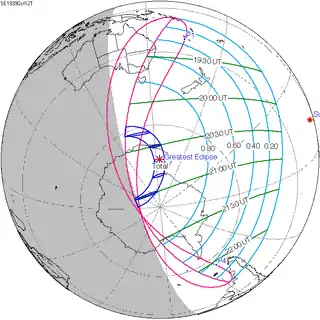 October 12, 1939 |
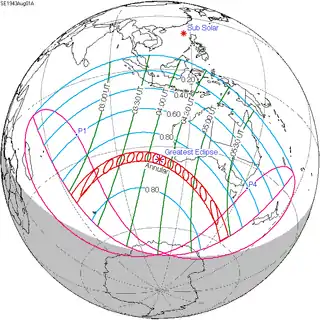 August 1, 1943 |
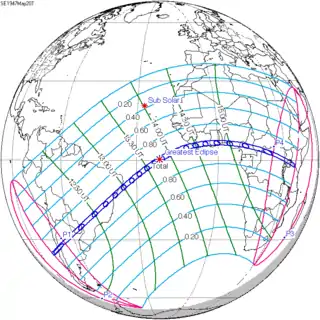 May 20, 1947 |
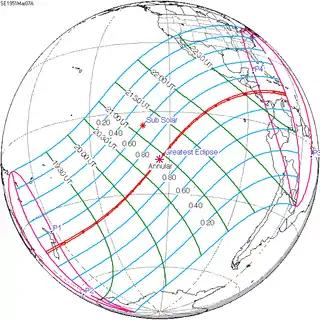 March 7, 1951 |
| 131 | 133 | 135 | 137 | 139 |
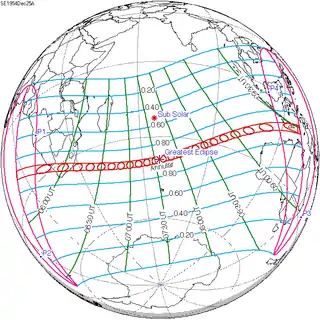 December 25, 1954 |
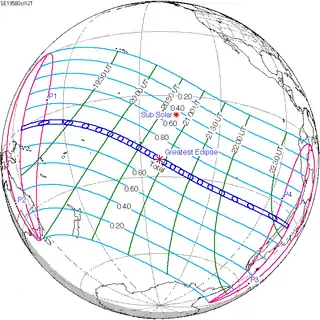 October 12, 1958 |
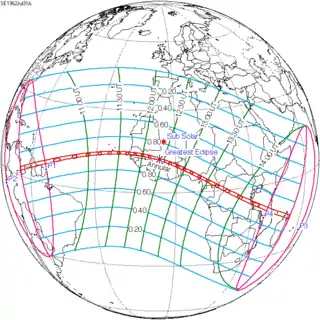 July 31, 1962 |
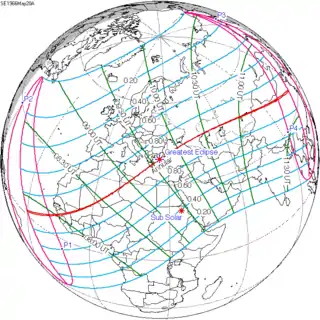 May 20, 1966 |
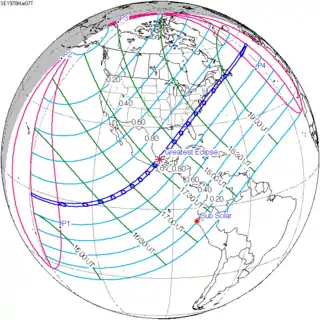 March 7, 1970 |
| 141 | 143 | 145 | 147 | 149 |
 December 24, 1973 |
 October 12, 1977 |
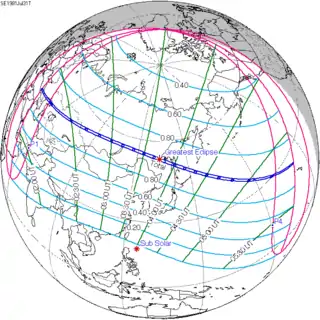 July 31, 1981 |
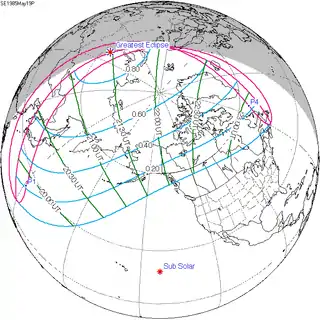 May 19, 1985 |
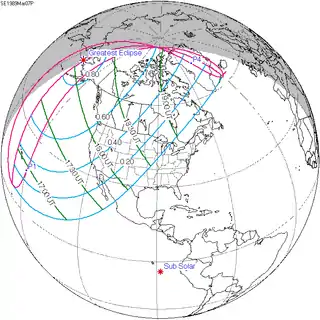 March 7, 1989 |
| 151 | 153 | 155 | 157 | 159 |
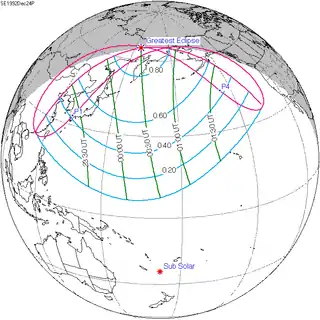 December 24, 1992 |
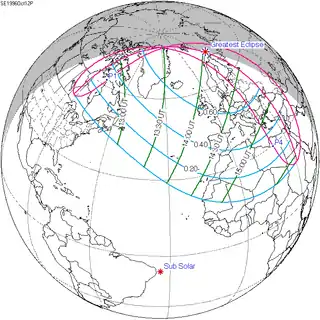 October 12, 1996 |
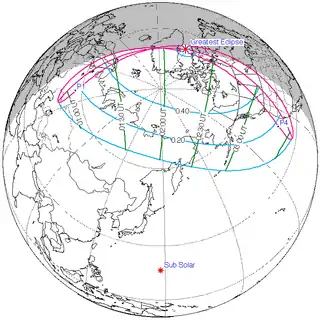 July 31, 2000 |
May 19, 2004 | March 7, 2008 |
| 161 | 163 | 165 | 167 | 169 |
| December 24, 2011 | October 13, 2015 | August 1, 2019 | May 19, 2023 | March 8, 2027 |
Notes
- "Annular Solar Eclipses with Durations Exceeding 11m 00s: -3999 to 6000". NASA Eclipse Web Site.
- van Gent, R.H. "Solar- and Lunar-Eclipse Predictions from Antiquity to the Present". A Catalogue of Eclipse Cycles. Utrecht University. Retrieved 6 October 2018.
- Saros Series Catalog of Solar Eclipses NASA Eclipse Web Site.
References
- Earth visibility chart and eclipse statistics Eclipse Predictions by Fred Espenak, NASA/GSFC
.jpg.webp)

